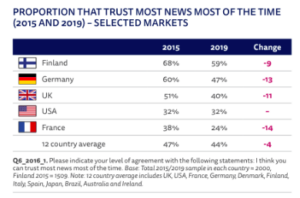Verification all the way down: the trouble with trust

In the short-term, maybe it isn’t all that bad that journalism is undergoing a trust crisis. Despite the fact that, per the last Reuters Institute Digital News report, 70 percent of people in the UK are now worried about the trustworthiness of news, news organisations aren’t even setting their sights as high as 30 percent of the public subscribing to their digital news products – and they don’t need to.
Even the fact that low double digit proportions of the public are happy to subscribe is enough to support subscription- and membership-based organisations like the Washington Post and the Guardian. For those organisations, at least, the journalism crisis is an opportunity to mobilise the few people who do trust their brand, even if it means abandoning attempts to engage with the ones that don’t.

Long-term, however, the reality is that a falling tide strands all boats. Diminished audience numbers across print news titles and the hoary old excuse of ‘fake news’ mean that newspapers are less influential than ever before – even when they suck up to anyone in any position of power – and that has a commensurate impact on how trusted they appear.
Consequently we are seeing a number of attempts to demonstrate that news media is not ‘fake news’, that it is in fact still performing the vital public service it always has. Most of those attempts are based upon the idea that news can be graded, or otherwise assigned a score that the public can easily use to identify its veracity.
The New York Times has just announced a raft of efforts to counter the environment engendered by the bad faith actors in news – those responsible for ‘fake news’ – and to prove that it isn’t responsible for online misinformation or biased reporting (no matter what Trump might say).
It has, for example, invoked the ‘b’ word (blockchain) to discuss making the veracity of a photo apparent to its readers: “By experimenting with publishing photos on a blockchain, we might in theory provide audiences with a way to determine the source of a photo, or whether it had been edited after it was published.
“In exploring the applications of blockchain for photojournalism, we hope to learn more about where and how it may be sensibly used for journalism as a whole.”
However, the issue with endeavours like that – and any other attempt from individual publishers to demonstrate the truth of their reporting – is that it puts the onus on the public to test it. It is, effectively, preaching to the converted: potentially some of their already loyal readers will check, but few if any of their detractors will bother. Worse, without the media literacy training required to understand the tech, many of those that do won’t necessarily understand it.
Even worse again, if a person doesn’t trust the reporting of a particular news outlet, they won’t suddenly trust any third party that claims to provide proof of the outlet’s truth. Instead, then, solutions to the news crisis need to be a combination of utter transparency of a paper’s operations and some behind-the-scenes technology.
For instance, the News Quality Score Index currently under development from analyst Frederic Filoux – deepnews.ai – is designed explicitly to meet this need: “this means coverage built on a genuine journalistic approach: depth of reporting, expertise, investigation, angle, ethical processes, and resources deployed by the newsroom.” The scheme, which we’ve covered on this blog before, is reportedly 80-85 percent accurate and, according to the announcement of its funding in the fourth round of the Google News Initiative, is designed to address the issue that “currently, there is no correlation between production costs associated with high-quality journalism and its tangible value”.
Since one of the stated goals of the scheme is to “match premium advertising with value-added, high scoring content – operating in real-time and using algorithms” – it will hopefully ensure that only the content judged to be truthful and able to prove its veracity via technological means will be served alongside valuable advertising, and ultimately in search results.
By taking the onus off the public to judge which news outlets are genuinely truthful, and marrying it to absolute transparency from the editorial staff, it might be possible to gradually reestablish trust in the news media. In the long term, that has benefits for both news business’ bottom lines and the communities they serve.
Chris Sutcliffe
enquiries@trippassociates.co.uk
Martin Tripp Associates is a London-based executive search consultancy. While we are best-known for our work across the media, information, technology, communications and entertainment sectors, we have also worked with some of the world’s biggest brands on challenging senior positions. Feel free to contact us to discuss any of the issues raised in this blog.